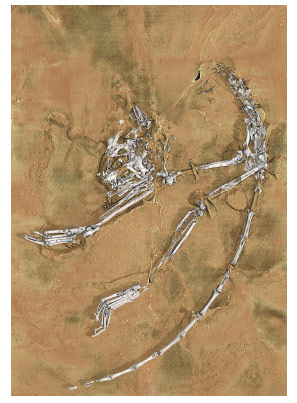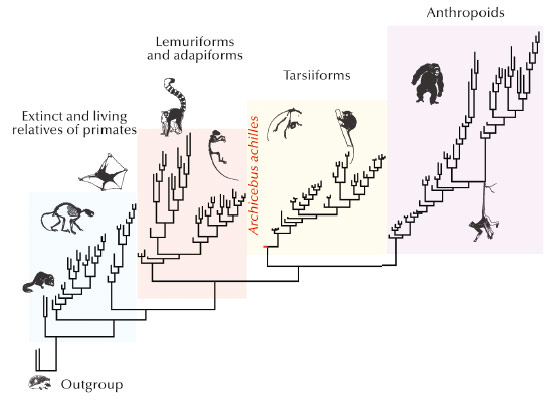- Home
- Users & Science
- Scientific Documentation
- ESRF Highlights
- ESRF Highlights 2013
- X-ray imaging
- Oldest known primate skeleton casting a new light on the origin of anthropoids
Oldest known primate skeleton casting a new light on the origin of anthropoids
Primates is a mammalian order that includes lemurs, tarsiers, monkeys, apes and human beings. The oldest known undoubted fossil primates are about 55 million years old [1]. Fossils from this era are extremely rare. Only bone fragments and isolated teeth of these earliest primates are previously known. We have discovered the world’s oldest known fossil primate skeleton representing a previously unknown genus and species named Archicebus achilles.
The fossil was unearthed from sedimentary rock strata that were deposited in an ancient lake roughly 55 million years ago, during the early part of the Eocene epoch, in central China’s Hubei Province, near the course of the modern Yangtze River. It is about 7 million years older than the oldest fossil primate skeletons known previously, which include Darwinius from Messel in Germany and Notharctus from the Bridger Basin in Wyoming.
Like most other fossils recovered from ancient lake strata, the skeleton of Archicebus was found by splitting apart the thin layers of rock containing the fossil. As a result, the skeleton of Archicebus is now preserved in two complementary pieces called a “part” and a “counterpart”, each of which contains elements of the actual skeleton as well as impressions of bones from the other side.
In order to study the entire fossil, we scanned the specimen at beamlines ID17 and ID19. We used a specific technology developed at the ESRF to examine those parts of the fossil that are still buried in the rock at a level of detail that is unique in the world. Three-dimensional digital reconstruction of the fossil using the synchrotron scans allowed us to study the tiny, fragile skeleton of Archicebus in intricate detail (Figure 11).
 |
|
Fig. 11: Three-dimensional reconstruction of the type specimen (IVPP V18618) of Archicebus Achilles, images acquired at ID17. |
Archicebus marks the first time that we have a reasonably complete picture of a primate close to the divergence between tarsiers and anthropoids. It represents a big step forward in our efforts to chart the course of the earliest phases of primate and human evolution.
Archicebus differs radically from any other primate, living or fossil, known to science. It looks like an odd hybrid with the feet of a small monkey, the arms, legs and teeth of a very primitive primate, and a primitive skull bearing surprisingly small eyes. Therefore in addition to being the oldest known example of an early primate skeleton, the new fossil is crucial for shedding light on a pivotal event in primate and human evolution.
The evolutionary relationships among primates and their potential relatives, and among the major lineages within the primate order have been debated intensively for many years [1,2]. To test the different hypotheses and determine the phylogenetic position of the new primate, we carried out cladistic analysis based on a huge database that includes both molecular and morphological information. The results of our analysis indicate that Archicebus belongs to an entirely separate branch of the primate evolutionary tree that lies much closer to the lineage leading to modern monkeys, apes and humans (Figure 12). Darwinius and Notharctus, on the other hand, are adapiform primates that are early relatives of living lemurs, the most distant branch of the primate family tree with respect to humans and other anthropoids.
 |
|
Fig. 12: Summary phylogenetic tree showing Archicebus achilles as the most basal taxa of tarsiiform primates. |
Even though Archicebus appears to be a very basal member of the tarsier lineage, it resembles early anthropoids in several features, including its small eyes and monkey-like feet. This suggests that the common ancestor of tarsiers and anthropoids was in some ways more similar than most scientists have thought.
Statistical analyses aimed at reconstructing how much an adult Archicebus would have weighed and what kind of activity pattern the animal would have had in life show that it was active during daytime and slightly smaller than the smallest living primates, which are pygmy mouse lemurs from Madagascar. The very basal evolutionary position of Archicebus supports the idea that the common ancestor of tarsiers and anthropoids was diurnal and miniscule. This overturns earlier ideas suggesting that the earliest members of primates were nocturnal and quite large.
Principal publication and authors
X. Ni (a,d), D.L. Gebo (b), M. Dagosto (c), J. Meng (d), P. Tafforeau (e), J.J. Flynn (d) and K.C. Beard (f), Nature 498, 60-64 (2013).
(a) Chinese Academy of Sciences (China)
(b) Northern Illinois University (USA)
(c) Northwestern University (USA)
(d) American Museum of Natural History (USA)
(e) ESRF
(f) Carnegie Museum of Natural History (USA)
References
[1] X. Ni, Y. Wang, Y. Hu and C. Li, Nature 427, 65-68 (2004).
[2] E.R. Seiffert, J.M.G. Perry, E.L. Simons and D.M. Boyer, Nature 461, 1118-1121 (2009).



